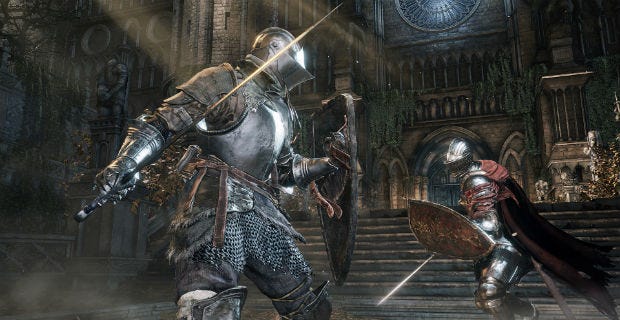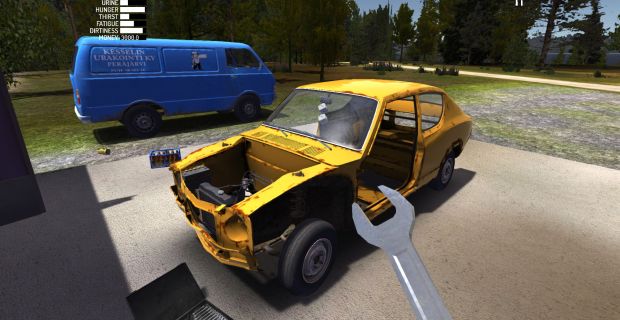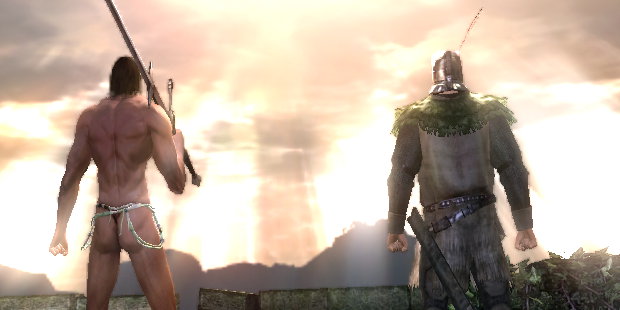In their haste to make "soulslikes", devs have forgotten what makes Dark Souls unique - its level design
A cold, dark and gentle place
I finally completed Dark Souls III [official site] last week, a world that I have been dipping in and out of between bouts of listlessness since its release in April last year. It didn’t grip me like the first revered Dark Souls, but it still made me sad to know it was all over. Where could I go now for my Souls fix? The answer, it turns out, is loads of places. The games industry is quietly reverberating with the series’ influence. From small games boasting “souls-like” combat, to bigger games doing weird things with death and player messages. Meanwhile, our PlayStation brethren got Nioh, which took the “pocket full o’ souls” idea and simply renamed them “Amrita”. There is a popular complaint that everything in the industry is now being compared to Dark Souls, and it's easy to forget that games embraced difficulty and strangeness long before the Bed of Chaos made you weep with frustration. Nevertheless, the mechanics and the tone of Miyazaki’s magnum opus is leaking into games everywhere.
That there's an influx of Soulsian disciples out there isn’t a problem to me. My problem is that they are learning all the wrong lessons. At least, they are neglecting the most important one. But first let’s look at what sly tricks are being lifted from the series, and who is lifting them.
Challenge
In the kind of cursed circles we games critics skulk in, any talk of difficulty in Souls games is greeted with gaseous sighs and eyes rolling around in skulls like wild pinballs. There is nothing to be said about the toughness of the game which has not already been said. The most recent soundbite I’ve heard is: “Dark Souls isn’t hard, you just need to learn!” - an analysis that screws up my face to the point of granting my eyebrows sentience, because it is like saying “that boiling hot cup of tea isn’t warm, you just need to slurp.” It is hard, it is famously hard, and we shouldn’t need to redefine an agreed-upon term just to find something new to say about a videogame. But we do, because, Jesus, we are exhausted.
For developers, that interest in difficulty seems not to have abated in the same way. Many devs have struggled through Anor Londo or Blighttown and concluded that challenge and difficulty are the things to take away from all of it. Hyper Light Drifter gives you a slowly-expanding set of moves to deal with numerous hard-hitting foes. Learning to time your dodges and take opportunistic potshots with a sidearm makes it feel at times like a top-down Bloodborne viewed through a pixelising Photoshop filter. You’ll die and you’ll have to try it all again.
More recently, the platformer Rain World adopted the use of Bonfire-like checkpoints. Your slugcat needs these shelters to survive a regular downpour of lethal rain yet are often placed far apart, stashed in as-yet unexplored places. You die easily to animals in this harsh landscape, with one-hit kills coming out of nowhere. Sometimes you become trapped in one area, unable to proceed or go back the way you came (although this has been eased thanks to a recent patch). But it also embraced the randomness of a real ecosystem, the deadly, uncaring attitude of nature. You could be going from one screen to another and be eaten as soon as you appeared on the other side, with no possible recourse. In this sense, Rain World is tougher than Dark Souls. Because it has done away with all sense of fairness.
There are other examples, mostly from independent developers. Salt and Sancuary, Titan Souls, Devil Daggers. They all have an emphasis on repetition, punishing overconfidence, building up your reflexes, observing enemy patterns, learning to intuit a foe’s movements. But not everything is done in pixels or platformers. Lords of the Fallen and Bound By Flame tried too hard to copy the big boy formula and both came away feeling uninspired. The point is: all of these games have their strengths and weakness, but they all take the challenge of Dark Souls to be its defining element. An understandable stance, since it is the most obvious and most praised aspect of the series. Hell, it’s first on this very list of “things wot Dark Souls teaches”. But it is not the only thing developers are learning.
Obfuscation
At no point during my first run of Dark Souls did I have any idea what I was doing. Not only in terms of the story, if it can be called a story, but also in my actions. A strange man would ask me a question and I would answer in the affirmative, not understanding why. I would equip a new weapon and wonder why I was suddenly rolling more slowly. A frog would burp on me and I’d panic that half of my health bar was now missing. Many of the systems and consequences are now rooted in players’ heads, like angry parasites, but it was not always so. Developers reminisce on games like this and conclude that a sense of mystery and discovery have been absent from videogames for far too long.
Thus, we are faced with oddities. My Summer Car is a comedy game that obfuscates its end goal in an extreme manner, asking you to build an entire car from scratch without a single clue, right down to the tiny bolts that hold each component in place. Attempting this challenge without help from YouTube is a time-consuming conundrum for anyone but a trained mechanic. Its insistence on having you build this rusty, ruinous old machine has led to the industry joke that “Dark Souls is the My Summer Car of RPGs”.
Rain World, again, hides many details from the player. It refuses to tell you the various hidden abilities of your slugcat (he can backflip, store things in his stomach, dash when squeezing through a pipe, and more, but none of that is explained) and there are moments of desperate cluelessness. Where am I going? What does this plant even do? Why are these glowing gold ghosts all flocking to this cavern?
Starseed Pilgrim tells you absolutely nothing about what is going on. I still do not understand what I was supposed to be doing in that game.
Harnessing mystery and discovery in strong ways like this can lead the player into any intriguing cave you want. But there is a point in which obfuscation turns some people off, especially when it comes to the story you are telling. Pulling too many veils over your story, far from granting it mystery, can simply feel like a cheap trick designed to make the player do the heavy narrative lifting. Dark Souls is certainly guilty of that and it has encouraged others to adopt this faux-Lynchian style of story-telling.
I always think of Kentucky Route Zero here, although I’ll be in the minority at Castle Shotgun for jabbing at it with an accusatory finger. It puts style and atmosphere over story, relegating connections between characters and events to the player’s own mind, never giving you a truly cohesive vision of its world or characters. It is random and it is vague. That might be grand for some people, but to me it is like finding a writer’s notebook – they might be a great writer, with a cutting turn of phrase and all the flair of Calvino, Borges, Atwood, or whoever your favourites are. They might be masterful, their sentences might ring off the page like songs. But you are still only reading their notes, there is no tale here, no rounded characters. You are squinting at scribbles.
And although the games are wildly different, that complaint is true for Dark Souls too – its story is bunk, half-formed lore gleaned from item descriptions and strangely translated utterances does not a storyline make. The appeal, yes, may be in filling in the blanks, but there comes a point when we, as readers, must ask: where the hell is the rest of this book? It's, like, two-thirds blank. It's possible to have mystery and mysticism, or a lack of direction, resolution or closure, and still have created a satisfactory story. You only need to look at any movie by the Coen brothers to know that.
The difference between Dark Souls and its growing clan of inspired descendants, is that it had something else to fall back on. When both challenge and a mysterious atmosphere was not enough, and it's something no disciple has since been able to replicate: a single, exquisitely crafted level.
Lordran

So here we are. Developers have taken so many tissue samples from Dark Souls that it is starting to look like one of its own goofy skeleton warriors. They’ve sliced off some of the challenge, and they’ve sucked up some of the mystery – all with varying degrees of success. But it is the boring, beating heart of level design that they should have extracted from its innards. Lordran has a unique sense of space, there is an idea in the first Dark Souls of “home” and of “camp”. We have all been stranded in some dark place. Maybe we were stuck at the roots of a tree or trapped in a cold, dark and gentle painting. But we have all felt, sometimes without knowing it, a longing to be back at the Firelink Shrine. And after a long slog, when you climb up that ladder, or open that crypt door, or step onto that mechanical lift, you discover yourself back there, and you are awarded a sense of relief and recognition unparalleled in other games. In this way, it is unlike its apostles, who seem to follow in its footsteps, but never reach the final destination.
The truth is that no game has learned that lesson, of investing in a nigh-perfect vertical-meets-horizontal level design, because even the Dark Souls series itself did not hold onto that philosophy. A shortcut in the first Dark Souls almost gave you as much of a buzz as defeating a towering dragon. A shortcut in the second feels like joyless mandatory inclusion, if it is there at all. And there are some shortcuts in the third that are virtually pointless.
It is why Demons’ Souls, with its hub world, doesn’t compare to the follow-up, it is why the sequels have never held a torch to the first, despite literally trying to. Their dogged insistence on immediately available fast travel and a shrine that is virtually disconnected from all other locations has turned what once felt like a journey into a matter of hopping up at your destination through a loading screen, like some sort of weird, teleporting rabbit. It’s a flaw I’ve mentioned before and others talk about constantly. Again I can already feel the pinball eyes of my critic pals rolling around in their heads with multiball chaos.
But if that problem is so obvious, why has it not been fixed? In the sequels you are offered this fast travel as a magical elevator, its muzak the gentle caress of loading screen tips. An elevator that conveniently stops in every rotten neighbourhood you’ve already encountered. If the true spirit and level design of Dark Souls had been retained, this would have manifested itself as an actual elevator. Or more likely, a warren-like system of shortcuts and detours - lifts, ladders and ledges – all created with a web-like consistency to bring you back the way you came. For a game with so much imagery and symbolism of cycles, Dark Souls III was a hundred times more linear than its elder brother.
To me, that descent into more conventional level design, with obligatory fast travel that was originally given later as a reward, is the result of a clash between what players think they want and what they truly want. They want to go on an epic journey, an adventure. But they don’t want too much hardship. They don’t want to travel long distances to return to a previous place they’ve already been. Yet in the first Dark Souls there was plenty of backtracking, and far from being something to complain about, it gave the game its soul.
I remember the exact moment I realised I loved Dark Souls. I had taken a long detour back to that old witchy undead woman near Firelink Shrine who sells poison arrows. I splashed down the sewer toward her hovel. I think it had taken me almost an hour to return here. But I had done it, and it was a revelation. The designers of Lordran wanted you, as the player, to know their land. The crumbling medieval ramparts, the rocky ledges of the canyons, the narrow brick corridors of the depths. They wanted you to know this world, not from a top-down perspective, or as list of places on a menu, but as an inhabitant. As a rat who knows what direction to take in his own labyrinth from nothing but a searing, instinctive memory. It is a critical attribute of Dark Souls, as a series, that it has no map. And yet, every one of us rats who got lost in its first labyrinth could probably draw you one.
I understand that this is just my view on it. The Souls series is special in that it is all things to all gamers (with the exception of those hollows who put the pad down at the Capra demon and decide to exact their madness elsewhere). But to me this is the takeaway lesson: there were hard games before Dark Souls, and there were mysterious games before Dark Souls, but there was no game with such exquisite and cyclic level design before Dark Souls. That the lessons interned in Lordran, lessons about what architecture and geography and mechanisms can add to an adventure all about hardship, could potentially be forgotten and put aside, for whatever reasons, would be the saddest loss of game design in a generation.
















